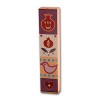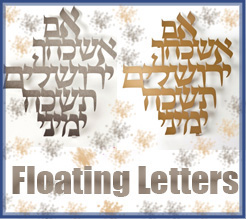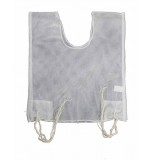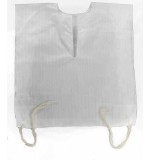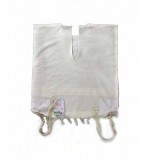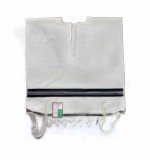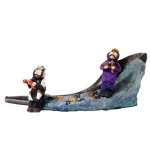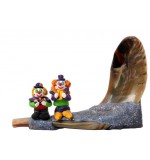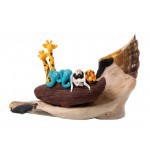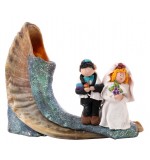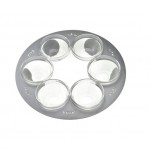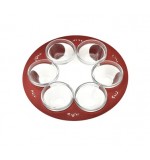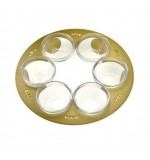Mezuzah
The Commandment of Mezuzah.
The source for the commandment to affix a Mezuzah by a doorway, is found in the Torah (Deuteronomy 6:9) “…and you shall write [these words that I command you] on the doorposts of your house and on your gateways”.
Our Sages explain this verse: there should be a constant reminder fixed to the doorpost of a person’s home, so that each time he enters or leaves his house he remembers G-d’s holy commandments and his duty to keep them. This ‘reminder’ is in the form of a small box, inside of which lies a piece of parchment inscribed with verses from the Torah.
There are those who see the Mezuzah as a form of protection on the house and those living inside, against adversity of any kind. There are also those who have the custom to kiss the Mezuzah as they pass by.
The term ‘Mezuzah’ is actually the Hebrew word for ‘doorpost’, on which it is affixed. The original meaning of the word ‘Mezuzah’, as it was referred to in the days of the Tanach, is the midpoint of the door-jamb.
What is written inside the Mezuzah?
Two paragraphs from the Tanach are inscribed onto the parchment inside the Mezuzah – ‘Shema Yisrael’ – Hear O Israel (Deut 6:4-9), and ‘Vehaya..’ - And it shall be if you will obey.. (Deut 11:13-21). Both of these passages contain the commandment of Mezuzah.
On the back of the parchment appear the word ‘Shakai’ – Shin, Daled, Yud, which is one of G-d’s Holy Names, and is also the acronym for the Hebrew ‘Shomer Daltot Yisrael’ – the One who guards the doors of [the people of] Israel.
There are three versions as to which script should be used by the scribe when writing the Mezuzah.
1. The script of the ‘Bet Yosef’ – this is the Ashkenazic script, written in accordance with the custom of R’ Yosef Karo, the ‘Bet Yosef’ (1488 – 1575). He was one of the greatest Rabbis and Halachic rulers of all generations, and the author of the ‘Shulchan Aruch’ and the ‘Bet Yosef’.
2. The script of the ‘Ari’. This is used by the Hasidic sect, and is inscribed according to the tradition of R’ Isaac Luria, the ‘Holy Ari’ (1534 – 1572). He was the master of all the Kaballists of Tzfas in the 16th Century. The difference between this script and the above, is evident in seven of the twenty-two letters of the Hebrew alphabet.
3. The third is the Sefardi script – the custom of Oriental and Yemenite Jews. This script is also termed ‘Mor U’Ktzia’, referring to the Sefer (holy work) ‘Mor U’ktzia’ which deals with the halachic details of this particular type of script.
The Mezuza is written by a ‘Sofer Stam’ - a scribe specialized and highly skilled at writing the unique script found in Mezuzot, Tefillin (phylacteries) and Torah Scrolls – the ‘Ksav Ashuri’ (Ashuri script). He is extremely learned in all the many intricate laws involved in the writing, and his extensive knowledge allows him to form each letter with perfect precision, exactly according to Jewish law and in the tradition that has been passed down from Moses as received on Mt. Sinai.
The Mezuzah is written on ‘Shallil’ parchment, produced from the skin of a kosher animal and tanned with lime. The Scribe uses a quill fashioned from a thick feather, which he dips in a deep black ink that has been manufactured exclusively for the purpose of writing in Mezuzot, Tefillin and Torah scrolls. This is exactly how they used to write in the days of the Tanach, and has been the tradition passed down from generation to generation.
After completing his writing, the Scribe then has to ‘crown’ the letters – seven out of the twenty-two letters of the Hebrew alphabet require crowns. A ‘crown’ is made up of three vertical lines extending from the top of the letter (circled in blue in the diagram below); each line ending in a tiny sphere:
Kashruth Certification.
The main requirements constituting a Kosher Mezuzah is, as mentioned: that it is written on parchment from a Kosher animal; with black ink; and the form of the letters must be according to the tradition passed down to us from Mt. Sinai. In addition to this, each time the Scribe writes the Holy Name of G-d, he must concentrate on specific, lofty thoughts.
Furthermore, the verses of the Mezuzah must be written exactly as they appear in the Torah – if a letter is missing, or if there is an extra letter, the Mezuzah is rendered Passul (non-kosher). That is why all the Mezuzot that we sell undergo a thorough manual proof-reading, as well as a computerized check that scans the forms of each letter, to determine that each one is formed correctly and that there are no missing/extra letters. Remember – a Mezuzah that is 99% Kosher is 100% Passul!
What is the size of the Mezuzah?
The size is determined by the sheet of parchment used by the Scribe. It is always square. We offer a wide range of sizes you could choose from - 20X20”, 15X15”, 10X10”, 12X12”, 6X6”.
How is the parchment inserted into the Mezuzah?
You must first roll the parchment from left to write (see diagram 1-2), and then wrap it in plastic in order to protect it from dampness or any other climate-related damage. Once that is done, the parchment is inserted into the case so that the letters forming the word ‘Shakai’ (Shin, Daled, Yud - as inscribed on the outside of the parchment) appear at the top and face towards the front of the case (see diagram 3-4 below – here ‘Shakai’ faces towards the ‘Shin’ on the outside of this Mezuzah case).
How is the Mezuzah affixed to the door?
Once the parchment has been inserted correctly, the case is then fixed onto the top third section of the right side of the door-post. The ‘right side’ is determined by the direction you are facing when you enter a room (as opposed to exiting). Every entranceway leading to a room that is in use requires a Mezuzah (excluding rooms where it wouldn’t be fitting to hang a Mezuzah, such as a bathroom etc.).
According to the Ashkenazic tradition, the Mezuzah is placed on a slant, with the upper part of the Mezuzah facing towards the room (see diagram 1). In the Sefardic version, the Mezuzah is placed upright; perpendicular with the ground (see diagram 2).
What is the Blessing upon hanging up the Mezuzah?
BORUCH ATO ADONOY ELO-HAYNU MELECH HO-OLOM ASHER KID`SHONU B`MITZVOSOV V`TZIVONU LIK’BOA MEZUZAH
(Loosely translated as: “… Who sanctified us with the commandment to affix a Mezuzah”)
Some add a second blessing:
"
BORUCH ATO ADONOY ELO-HAYNU MELECH HO-OLOM SHE’HECHEYONU V’KIYMONU V’HIGI’ONU LAZMAN HAZEH
(“…Who has kept us alive, sustained us and brought us to this time”)
Note: When fixing a number of Mezuzot, a blessing is only made on the first Mezuzah.
Who is eligible to hang up the Mezuzah:
The obligation to fix a Mezuzah at the entrance of one’s house (and at all the other entrances inside the house) is incumbent on every Jew, and women are also obligated in this commandment. In a case where there is no man over the age of Bar-Mitzvah (thirteen), a woman may fix the Mezuzah herself and must recite the appropriate blessing.
In which case is a blessing recited on hanging up a Mezuzah?
One must only recite the blessing if a Mezuzah has never been fixed in that place at all; or when the Mezuzah itself is new (even if there was a Mezuzah there before). In the event a Mezuzah is removed for inspection, no blessing is necessary upon re-fixing it to the door-post. However, if the Mezuzah was found to be Passul (non-Kosher), it must be placed in ‘Genizah’ (a collection point for religious articles on their way to burial), and when a new Mezuzah is purchased and fixed on the door-post, a new blessing is indeed necessary.
What is the importance of the Mezuzah in Jewish tradition?
The Mezuzah has always been known to safeguard and protect the house, as mentioned before. It is also brought down in ancient sources, that he who keeps the commandment of Mezuzah merits longevity – as our Sages say (Shabbath 32) “Long life is seen by those who have a Mezuzah at the entrance to their home, since near the verse in Tanach ‘…and you shall write on the doorposts of your house’, appears the verse ‘In order that your days be many…’”
In the Torah it states that when making Tzitzit, one must include a Techelet- colored string. Techelet is a shade similar to purple. In earlier times, it was a prestigious color that only the wealthy used. Our Sages give a reason for the requirement of the Techelet string: the color Techelet is reminiscent of the color of the sky (sky-blue), and therefore reminds a person of G-d, Who dwells on High. The words of the Torah itself indicate this: "And put onto the corner-fringe a Techelet thread … and you should see it and remember all the laws of G-d…”
According to tradition, the Techelet –dye was extracted from a specific sea fish called the Chilazon. It is clear from several places in the Torah that the color Techelet was one of the prestigious colors of ancient times, also used for the priestly garments and the curtains in the Temple. In the Byzantine era, harsh decrees were issued against the private use of Techelet, making it increasingly more precious and difficult to obtain – this in addition to the difficulty of extracting the dye itself. At the beginning of the Islamic period, the production of Techelet -dye was halted completely. Subsequently, it was ruled halachically that ‘Techelet does not inhibit the white’; and so the custom is to wear Tzitzit even without the Techelet thread.
For many years the origin of the Techelet dye used in the times of Tanach, was not known. However, recently a group of Rabbis conducted extensive research and discovered piles of `Argaman` shells in an ancient ‘dye’ center on the shore of the Mediterranean Sea. Evidence of ancient scientific symbols, in addition to chemical analysis, all point to the accuracy of the claim that ‘Murex Trunculus’ is the source of the Techelet used in the time of the Torah. In addition to this, the ever rising number of the Rabbinic authorities and Halachic experts who actually wear this Techelet thread strengthen this claim.
The `Argaman` fish were found by the shores of the Mediterranean. In old Israel, the Chilazon fish were caught mostly in the area of the tribe of Zebulun, on the North-East shore of the Mediterranean Sea. Archaeological diggings in this region revealed remains of the manufacture of the dye and broken shells of the `Argaman`. Today the `Argaman’ species is protected by Israeli law, and so the raw material is brought from other areas of the Mediterranean Sea such as Spain and Greece, where these fish are caught to be used as food.
According to estimation, about thirty Chilazon fish are required for just one set of Tzitzit. This number is subject to change depending on the time of fishing, the place of fishing and the technology used to extract the raw material, etc.
Since there is no real tradition as to what the Techelet of the Torah was actually extracted from, there are many who do not wear Tzitzit with Techelet. However, Rav Zilberman of the Old City of Jerusalem, who was part of the group that conducted the above-mentioned research, ruled that the Techelet was in fact extracted from the fish Murex Trunculus, and those who wear the Techelet thread on their Tzitzit rely on this ruling.
